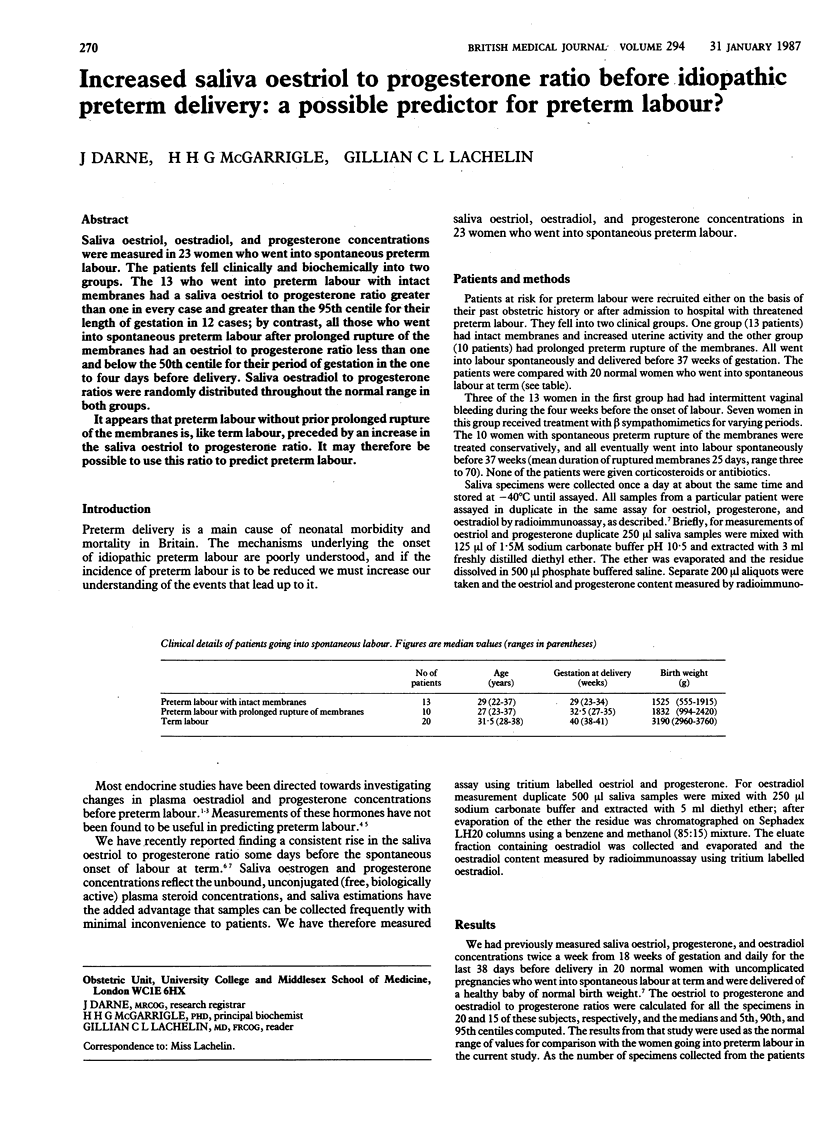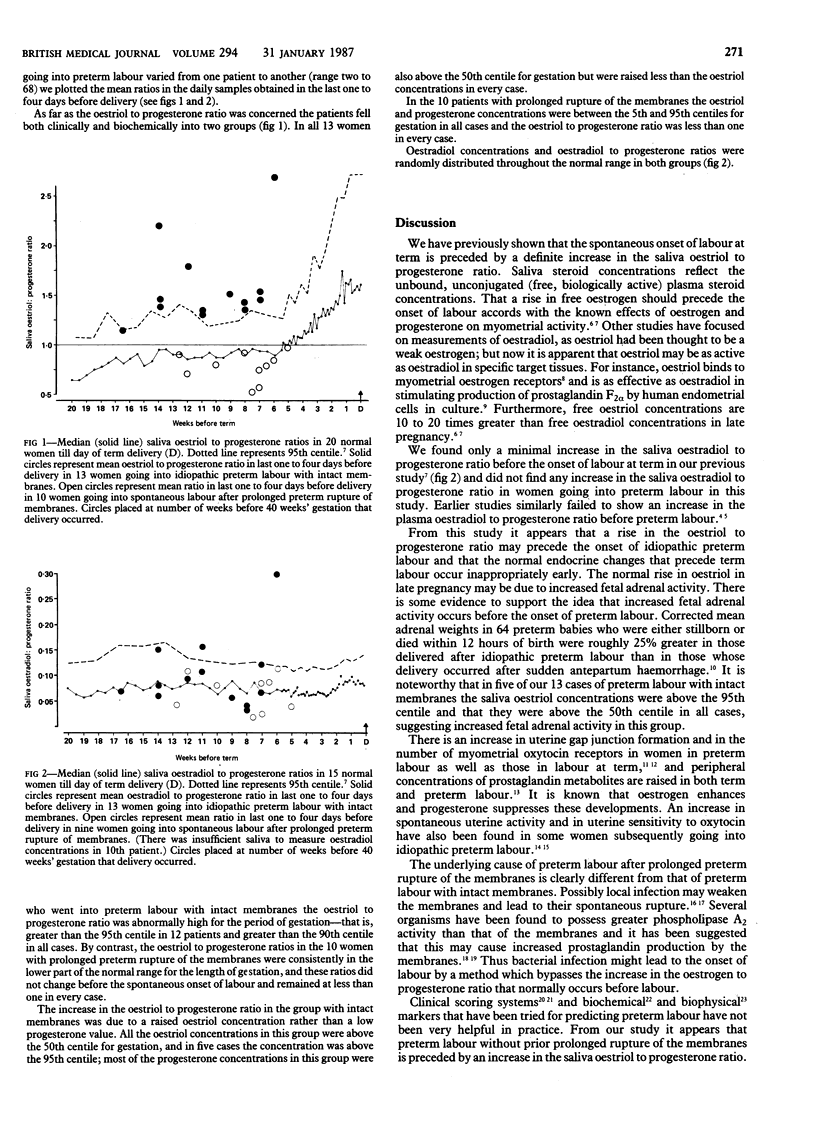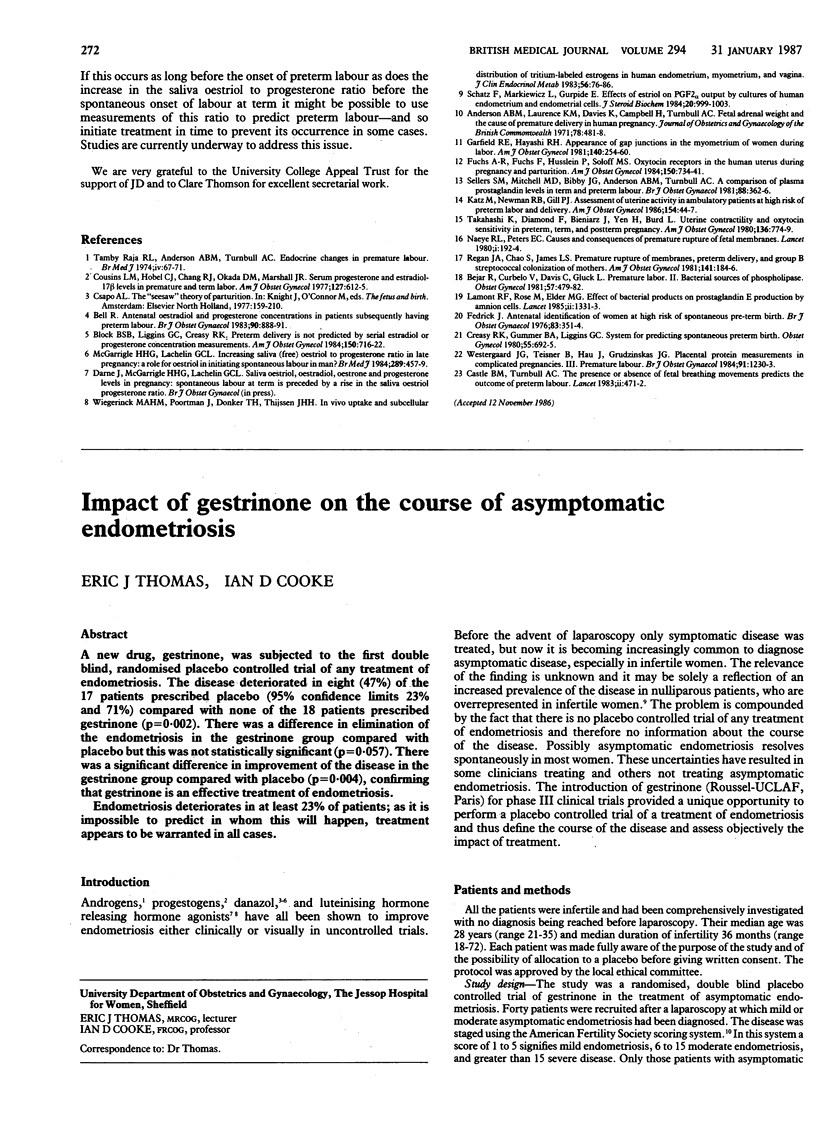Abstract
Saliva oestriol, oestradiol, and progesterone concentrations were measured in 23 women who went into spontaneous preterm labour. The patients fell clinically and biochemically into two groups. The 13 who went into preterm labour with intact membranes had a saliva oestriol to progesterone ratio greater than one in every case and greater than the 95th centile for their length of gestation in 12 cases; by contrast, all those who went into spontaneous preterm labour after prolonged rupture of the membranes had an oestriol to progesterone ratio less than one and below the 50th centile for their period of gestation in the one to four days before delivery. Saliva oestradiol to progesterone ratios were randomly distributed throughout the normal range in both groups. It appears that preterm labour without prior prolonged rupture of the membranes is, like term labour, preceded by an increase in the saliva oestriol to progesterone ratio. It may therefore be possible to use this ratio to predict preterm labour.
Full text
PDF


Selected References
These references are in PubMed. This may not be the complete list of references from this article.
- Anderson A. B., Laurence K. M., Davies K., Campbell H., Turnbull A. C. Fetal adrenal weight and the cause of premature delivery in human pregnancy. J Obstet Gynaecol Br Commonw. 1971 Jun;78(6):481–488. doi: 10.1111/j.1471-0528.1971.tb00305.x. [DOI] [PubMed] [Google Scholar]
- Bejar R., Curbelo V., Davis C., Gluck L. Premature labor. II. Bacterial sources of phospholipase. Obstet Gynecol. 1981 Apr;57(4):479–482. [PubMed] [Google Scholar]
- Bell R. Antenatal oestradiol and progesterone concentrations in patients subsequently having preterm labour. Br J Obstet Gynaecol. 1983 Oct;90(10):888–891. doi: 10.1111/j.1471-0528.1983.tb06758.x. [DOI] [PubMed] [Google Scholar]
- Block B. S., Liggins G. C., Creasy R. K. Preterm delivery is not predicted by serial plasma estradiol or progesterone concentration measurements. Am J Obstet Gynecol. 1984 Nov 15;150(6):716–722. doi: 10.1016/0002-9378(84)90674-4. [DOI] [PubMed] [Google Scholar]
- Castle B. M., Turnbull A. C. The presence or absence of fetal breathing movements predicts the outcome of preterm labour. Lancet. 1983 Aug 27;2(8348):471–473. doi: 10.1016/s0140-6736(83)90508-1. [DOI] [PubMed] [Google Scholar]
- Cousins L. M., Hobel C. J., Chang R. J., Okada D. M., Marshall J. R. Serum progesterone and estradiol-17beta levels in premature and term labor. Am J Obstet Gynecol. 1977 Mar 15;127(6):612–615. doi: 10.1016/0002-9378(77)90359-3. [DOI] [PubMed] [Google Scholar]
- Creasy R. K., Gummer B. A., Liggins G. C. System for predicting spontaneous preterm birth. Obstet Gynecol. 1980 Jun;55(6):692–695. [PubMed] [Google Scholar]
- Fuchs A. R., Fuchs F., Husslein P., Soloff M. S. Oxytocin receptors in the human uterus during pregnancy and parturition. Am J Obstet Gynecol. 1984 Nov 15;150(6):734–741. doi: 10.1016/0002-9378(84)90677-x. [DOI] [PubMed] [Google Scholar]
- Garfield R. E., Hayashi R. H. Appearance of gap junctions in the myometrium of women during labor. Am J Obstet Gynecol. 1981 Jun 1;140(3):254–260. doi: 10.1016/0002-9378(81)90270-2. [DOI] [PubMed] [Google Scholar]
- Katz M., Newman R. B., Gill P. J. Assessment of uterine activity in ambulatory patients at high risk of preterm labor and delivery. Am J Obstet Gynecol. 1986 Jan;154(1):44–47. doi: 10.1016/0002-9378(86)90390-x. [DOI] [PubMed] [Google Scholar]
- Lamont R. F., Rose M., Elder M. G. Effect of bacterial products on prostaglandin E production by amnion cells. Lancet. 1985 Dec 14;2(8468):1331–1333. doi: 10.1016/s0140-6736(85)92628-5. [DOI] [PubMed] [Google Scholar]
- McGarrigle H. H., Lachelin G. C. Increasing saliva (free) oestriol to progesterone ratio in late pregnancy: a role for oestriol in initiating spontaneous labour in man? Br Med J (Clin Res Ed) 1984 Aug 25;289(6443):457–459. doi: 10.1136/bmj.289.6443.457. [DOI] [PMC free article] [PubMed] [Google Scholar]
- Naeye R. L., Peters E. C. Causes and consequences of premature rupture of fetal membranes. Lancet. 1980 Jan 26;1(8161):192–194. doi: 10.1016/s0140-6736(80)90674-1. [DOI] [PubMed] [Google Scholar]
- Regan J. A., Chao S., James L. S. Premature rupture of membranes, preterm delivery, and group B streptococcal colonization of mothers. Am J Obstet Gynecol. 1981 Sep 15;141(2):184–186. doi: 10.1016/s0002-9378(16)32589-3. [DOI] [PubMed] [Google Scholar]
- Schatz F., Markiewicz L., Gurpide E. Effects of estriol on PGF2 alpha output by cultures of human endometrium and endometrial cells. J Steroid Biochem. 1984 Apr;20(4B):999–1003. doi: 10.1016/0022-4731(84)90010-4. [DOI] [PubMed] [Google Scholar]
- Sellers S. M., Mitchell M. D., Bibby J. G., Anderson A. B., Turnbull A. C. A comparison of plasma prostaglandin levels in term and preterm labour. Br J Obstet Gynaecol. 1981 Apr;88(4):362–366. doi: 10.1111/j.1471-0528.1981.tb00997.x. [DOI] [PubMed] [Google Scholar]
- Takahashi K., Diamond F., Bieniarz J., Yen H., Burd L. Uterine contractility and oxytocin sensitivity in preterm, term, and postterm pregnancy. Am J Obstet Gynecol. 1980 Mar 15;136(6):774–779. doi: 10.1016/0002-9378(80)90455-x. [DOI] [PubMed] [Google Scholar]
- Tamby Raja R. L., Anderson A. B., Turnbull A. C. Endocrine changes in premature labour. Br Med J. 1974 Oct 12;4(5936):67–71. doi: 10.1136/bmj.4.5936.67. [DOI] [PMC free article] [PubMed] [Google Scholar]
- Westergaard J. G., Teisner B., Hau J., Grudzinskas J. G. Placental protein measurements in complicated pregnancies. III. Premature labour. Br J Obstet Gynaecol. 1984 Dec;91(12):1230–1233. doi: 10.1111/j.1471-0528.1984.tb04742.x. [DOI] [PubMed] [Google Scholar]
- Wiegerinck M. A., Poortman J., Donker T. H., Thijssen J. H. In vivo uptake and subcellular distribution of tritium-labeled estrogens in human endometrium, myometrium, and vagina. J Clin Endocrinol Metab. 1983 Jan;56(1):76–86. doi: 10.1210/jcem-56-1-76. [DOI] [PubMed] [Google Scholar]


